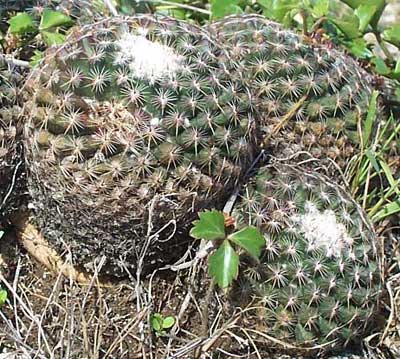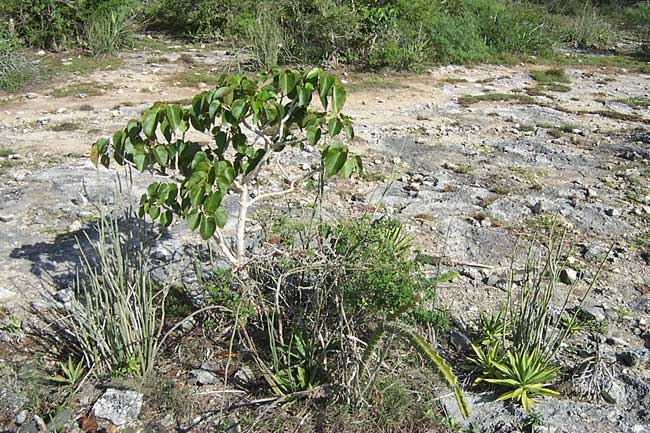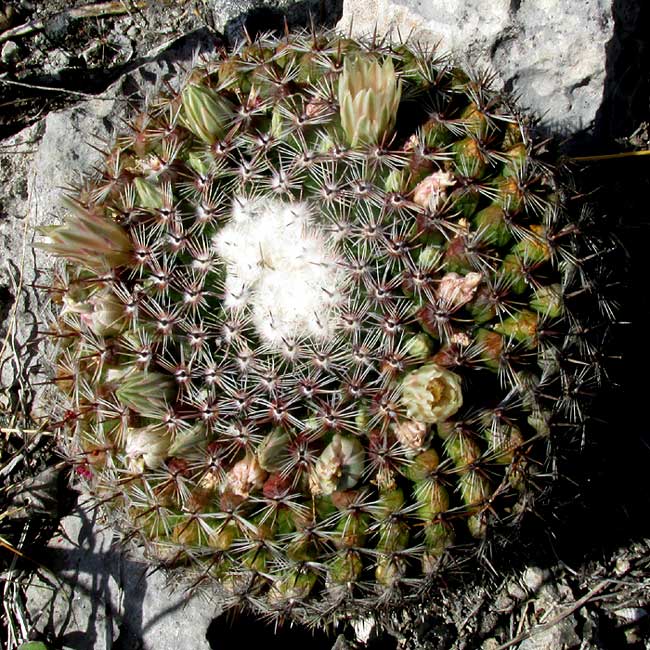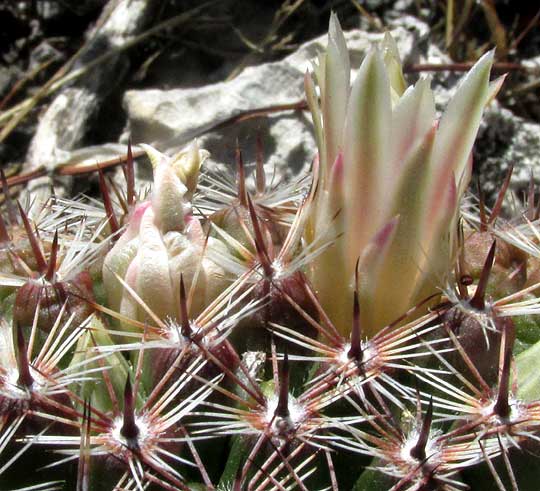Excerpts from Jim Conrad's
Naturalist Newsletter
from the November 13, 2006 Newsletter issued from Río Lagartos, on the Yucatan Peninsula's northern coast (~N21.60°, ~W88.16°), Yucatán state, MÉXICO The single road running into Río Lagartos comes up exactly from the south. Houses at the edge of town extend into the mangroves, at high tide having water lapping against their foundations. South of the mangroves there's an amazing transition zone where you can see glossy- leafed, sprawling, wetland mangroves standing next to scrubby, spiny, arid-land plants typical of inland northern Yucatan. What's happening is that wherever saltwater occasionally floods the almost-flat, very-slightly undulating land, even if only during the rarest high tide, mangrove gets established. But just beyond that high-tide mark -- and that can be only a couple of feet away -- then the vegetation mainly reflects climate, not tides or soil salinity. And the northern Yucatan's climate produces scrub. Below, you can see how deserty the vegetation can look, even when standing only a few feet from mangrove swamp: In the above picture I think the broadleaf bush with a pale, semi-succulent trunk is a Jatropha, possibly J. gaumeri. The grayish-green, long, slender, leafless stems are Pedilanthuses, Euphorbia personata. You may recognize a young Agave, and the arching, four-ribbed cactus is Acanthocereus tetragonus. This glimpse of the scrub zone's exotic nature may help you imagine my frustration that no field guides are available to help me identify plants here. The problem is especially aggravating because so many of these arid-land species are endemic -- found nowhere else on Earth. Plant endemism has been estimated to reach nearly 10% of the Yucatan's Dry Forest vegetation. Northwestern Yucatan, the most arid part, is home to 10 of the Peninsula's 14 endemic cacti species. The other day I was walking along the road running north to Río Lagartos, passing through the scrub zone, when Diego pulled up beside me in his car. "Want to see Mammillaria gaumeri," he asked, knowing full well I'd be thrilled. Mammillaria gaumeri is one of those rare, narrowly endemic species that would delight any naturalist. We found it growing not 50 feet from the highway, right along a trail Diego uses for his birding walks. That's the picture I took of it at the top of this page. I have no way of knowing for sure that this really is the endemic Mammillaria gaumeri since it's not flowering and I don't know what distinguishes the species from other Mammillarias. A specialist told Diego it was Mammillaria gaumeri and now Diego has told me. I'm sure it's a Mammillaria, and the Flora of Quintana Roo -- the state just east of here -- lists only one Mammillaria species for that state, and that's gaumeri, so probably it is. Mammillarias are easy to identify as a group because their more or less spherical cactus bodies are composed of many protruding green bumps -- like a lot of green chili peppers packed together so their roundish bottoms face outward. The botanist who named the genus was thinking in terms of lots of round teats, thus the name Mammillaria, from the Latin "mamila," meaning "nipple- like." If you want to learn about just one, easy-to-recognize cactus group, the genus Mammillaria makes a good choice. A website for learning all about the genus is at http://www.mammillarias.net/index.php. By the way, here in the northern Yucatan I'm constantly running into unusual plants bearing the species name "gaumeri." Earlier we had Jatropha gaumeri. "Gaumeri" is the Latinized form of the name Gaumer. George Franklin Gaumer (1850-1929) was a US citizen residing in the Yucatan from 1884 to his death, and he collected a remarkable number of rare and endemic species, which he sent to specialists for identification or, if they were unknown to science, for naming. Many of those specialists named the undescribed plants after their discoverer, Gaumer. There's Acacia gaumeri, Caesalpinia gaumeri, Thevetia gaumeri, Vitex gaumeri, and many more. What a heck of a lot of fun that guy must have had as he explored a land basically unknown to biologists!
GAUMER'S MAMMILLARIA


from the March 15, 2015 Newsletter issued from Río Lagartos, on the Yucatan Peninsula's northern coast (~N21.60°, ~W88.16°), Yucatán state, MÉXICO
GAUMER'S MAMMILLARIA FLOWERING
Nowadays this low, barrel-type cactus is producing small, creamy-white flowers, as shown below:

A close-up of a flower as well as the interesting spine clusters, each atop a "tubercle" shaped like a green chili pepper, appears below:
